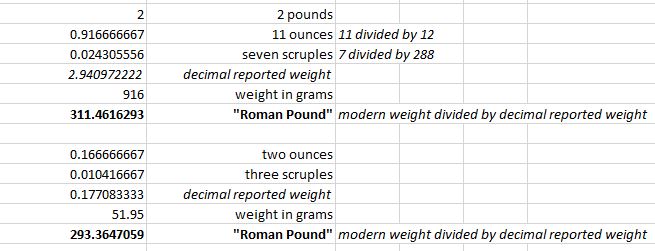
This hoard of silver is Tivoli and thought to be late republican in date.
You can go see it in the Met in NYC.
My interest (today) is in the reported weights and the inscriptions on one of the two cups and the ladle as reported in:
Oliver, Andrew Jr. 1965. “Two Hoards of Republican Silver.” Bulletin of the Metropolitan Museum of Art, 23(5): pp. 176–77.


So if we do some math and are a little less sure that Roman pound was 327 grams exactly this is what the objects tell us about the ball park of the Roman pound.

I don’t know how much is likely to be worn away from polishing or chemical reactions over time. Both factors. Another factor is I’m not so sure on the resolution of the number II P(ondo) seems clear but then I see IIS (2.5?) and then four dots follows by SC VII. Not sure how IIS plus for dots = 11 ounces….
The precision must be performative, not just ‘theft’ prevention. (We don’t see shaving of coins in the republic or Roman world generally). I’m guessing these pieces may have been part of dowry for which an exact value was recorded and that the recording of the weight on the object is part of the performance of the fulfillment of that obligation.
The pitcher (oinochoe) from the Arcisate Treasure is also thought to be Campanian manufacture and 1st Cent BCE and also has a woman’s name. It’s 350 grams and claims to be precisely a pound (BM 1900,0730.4):
—
Another that is hard to transcribe:






Bibliography on other silverware with weight inscriptions
Late antique plate in Getty with large disparity between inscribed weight and reconstructed weight.
This MET mirror (Campania? 1st Cent AD?) is supposed to have a weight and owner’s name inscription, but I cannot see it…, ILL-ed Bibliography…

